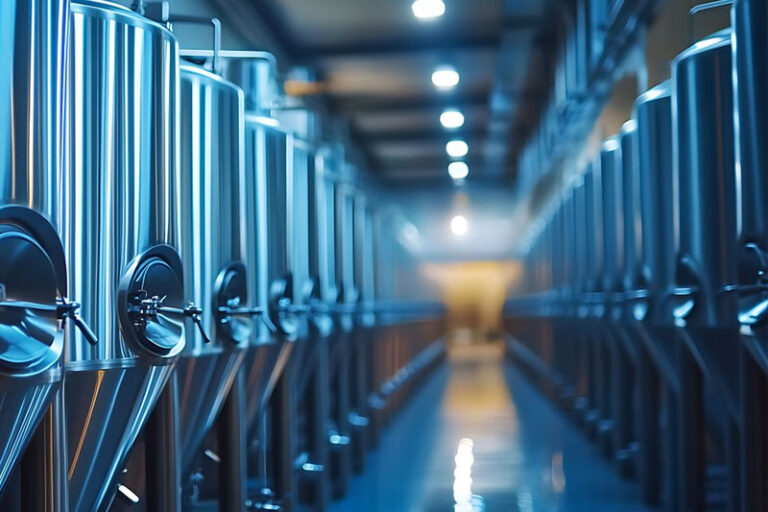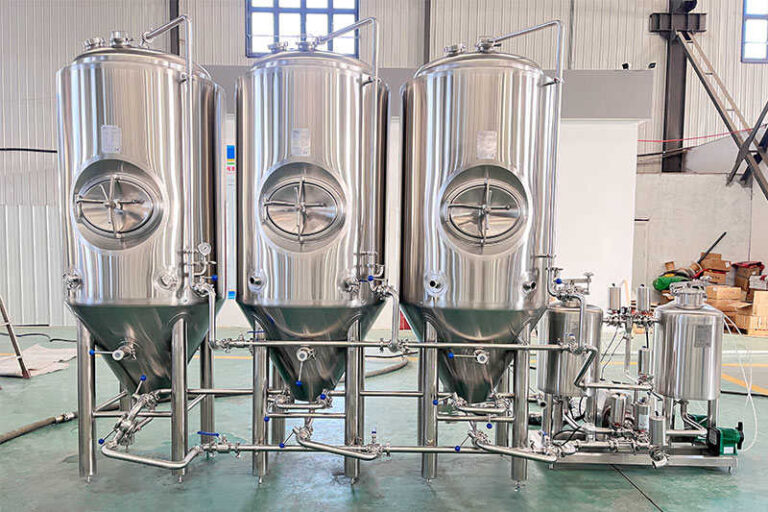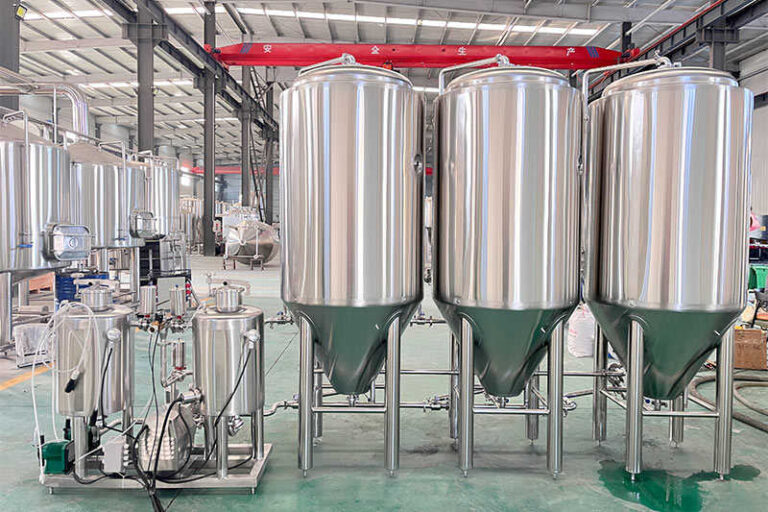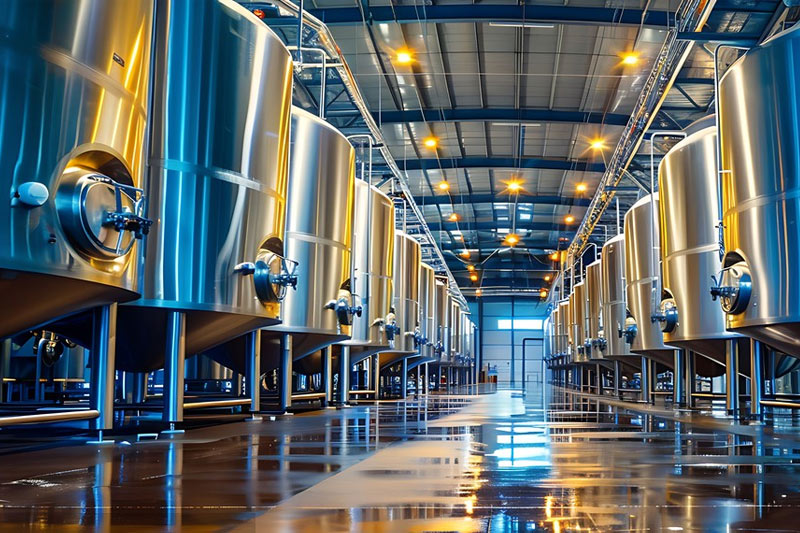Beer brewing is a precise and artistic process, in which the fermentation process is the key step to determine the quality of beer. In this process, the fermentation tank, as a core equipment, plays an irreplaceable role. With the development of beer brewing technology, stainless steel fermentation tanks have become the first choice for modern breweries and home brewers due to their excellent durability, easy cleaning, and strict control of the brewing environment.
What is a stainless steel beer fermentation tank?
Stainless steel beer fermentation tanks are containers used in the beer fermentation process, usually made of food-grade stainless steel (such as 304, and 316 stainless steel). It is used to store and ferment beer wort. During the process, yeast converts the sugar in the wort into alcohol and carbon dioxide to generate a unique beer flavor. Compared with traditional wooden barrels, ceramic tanks, or plastic tanks, stainless steel fermentation tanks have many advantages, especially in terms of sealing, corrosion resistance, easy cleaning, and food safety.

Advantages of stainless steel beer fermentation tanks
Excellent corrosion resistance
Stainless steel is extremely resistant to corrosion and can maintain its original strength and appearance even when in contact with water, yeast, and other chemicals for a long time. Compared with traditional wooden barrels or plastic containers, stainless steel fermentation tanks can effectively avoid the growth of bacteria and microorganisms, reduce possible contamination problems during alcohol fermentation, and ensure the quality and safety of beer.
Excellent sealing performance
Stainless steel fermentation tanks are sealed to prevent oxygen from entering to the maximum extent. During the fermentation process, yeast consumes sugar in the wort and releases carbon dioxide. If oxygen enters the tank, it will cause oxidation of the beer, produce bad odors, and even affect the flavor. Therefore, the excellent sealing of stainless steel fermentation tanks can effectively prevent this from happening and ensure the stability of the flavor of the beer.
Easy to clean and maintain
Stainless steel has a smooth, strong surface and is not easy to adhere to impurities, making it very easy to clean. Most modern stainless steel fermentation tanks are equipped with a CIP (cleaning in place) system that can be cleaned quickly and effectively. Breweries and home brewers can save a lot of time and labor costs, keep equipment hygienic, and reduce the growth of bacteria and mold.
High food safety
Stainless steel materials meet international food-grade standards and will not release harmful substances, ensuring that the beer will not be contaminated throughout the brewing process. In contrast, plastic or inferior metal materials may contain harmful chemical components, and may release toxic substances after long-term contact with wort or alcohol, which will have a negative impact on the taste and safety of beer.
Excellent high temperature resistance
During the beer brewing process, the temperature inside the fermentation tank usually needs to be kept within a certain range. High-quality stainless steel fermentation tanks can withstand high temperatures and will not be deformed or damaged due to temperature differences or high temperature environments. Its high temperature resistance makes it particularly suitable for craft beer with strict fermentation temperature control.
Long-term durability
Stainless steel has extremely high mechanical strength and can withstand the test of long-term use. Even after multiple fermentation processes, the fermentation tank will not have problems such as wear and corrosion, which extends the service life of the equipment. This not only reduces the replacement cost of the brewer but also reduces the frequency of repairs and maintenance.

Types of stainless steel beer fermentation tanks
Open fermentation tanks
Open fermentation tanks are often used in traditional brewing processes. There is no sealing cover on the top, and the yeast is in direct contact with the air. Although the design of this type of tank is relatively simple, it is easily contaminated by oxygen and bacteria in the air because it is not sealed. Open fermentation tanks are usually suitable for those types of beer that need to be in contact with air during the fermentation process, such as some Belgian beers or wheat beers with special flavors.
Closed fermentation tanks
Closed fermentation tanks are currently the most common type of fermentation tanks. It has good sealing and can effectively prevent air from entering, avoiding oxidation and contamination. Closed fermentation tanks are suitable for most brewing processes, especially in industrial beer production, where it helps to improve fermentation efficiency and ensure beer quality.
Conical fermentation tanks
The bottom of the conical fermentation tank is conical, which is suitable for collecting deposited yeast and residues, and is convenient for yeast recovery after fermentation. This design can effectively improve fermentation efficiency, especially for brewing processes that need to control yeast sedimentation and waste discharge. Conical fermentation tanks are widely used in craft beer and commercial breweries.
Bright tanks (maturing tanks)
Bright tanks, also known as maturing tanks, are fermentation tanks used for beer maturation and clarification. They are mainly used to store beer that has completed initial fermentation and can further remove impurities to improve the taste and clarity of beer. Bright tanks are usually equipped with temperature control systems to help maintain the appropriate temperature and can perform carbonation with carbon dioxide.
Plastic fermentation tanks
Although not as durable as stainless steel fermentation tanks, plastic fermentation tanks are often used by home brewers. They are lightweight and low-cost, but because they are not as durable as stainless steel, they have a shorter lifespan and may absorb odors or oxidize over time, so they are not suitable for long-term use.
How to choose the right stainless steel beer fermentation tank?
Determine the capacity of the fermentation tank.
Choose the right material.
Stainless steel material is crucial to the quality of beer fermentation tanks. The two most commonly used stainless steel materials are 304 stainless steel and 316 stainless steel. They both have strong corrosion resistance, but 316 stainless steel is more corrosion-resistant than 304 stainless steel, especially when exposed to acidic substances.
- 304 stainless steel: This material is relatively low in price and widely used in beer brewing equipment. It has excellent corrosion resistance and is suitable for most beer brewing occasions.
- 316 stainless steel: 316 stainless steel has stronger corrosion resistance and is suitable for harsh brewing environments (such as brewing processes with frequent contact with high concentrations of acidic substances), or it can maintain a high standard of hygiene after long-term use. It is relatively expensive, but if the budget allows, choosing 316 stainless steel can improve the durability of the equipment.

Consider the temperature control system.
The temperature control system is an important factor in ensuring the smooth progress of the brewing process. Yeast ferments differently at different temperatures, so a temperature control system is needed to ensure the stability of the temperature in the fermentation tank. Many stainless steel fermentation tanks are equipped with a jacket temperature control system, which adjusts the temperature in the fermentation tank through cold or hot water in the jacket.
Cleaning and maintenance design
Good cleaning design is the key to ensuring beer quality and hygiene. The surface of the stainless steel fermentation tank should be as smooth as possible, avoiding dead corners and gaps, so that it can be easily cleaned and disinfected.
- CIP system: Some high-quality stainless steel fermentation tanks are equipped with a CIP system, which can automatically clean the tank, reduce the labor of manual cleaning, and ensure more efficient cleaning results.
- Manual cleaning: For some smaller fermentation tanks, manual cleaning may still be the main cleaning method. Although it is more time-consuming and labor-intensive than automatic cleaning, it can still ensure the hygiene of the fermentation tank.
Budget and cost
Budget is a factor that cannot be ignored when choosing a fermentation tank. High-quality stainless steel fermentation tanks are more expensive, but their durability, easy cleaning, and guarantee of beer quality are irreplaceable. If the budget is limited, you can choose a more basic model, but make sure its basic functions can meet your needs.
Summary
Stainless steel fermentation tank brewing equipment. The correct selection and reasonable use of stainless steel fermentation tanks can not only improve brewing efficiency, but also effectively improve the flavor and quality of beer. Whether it is a home beer enthusiast or a professional brewery, understanding and mastering how to choose and use fermentation tanks is the key to achieving a high-quality beer production process.

